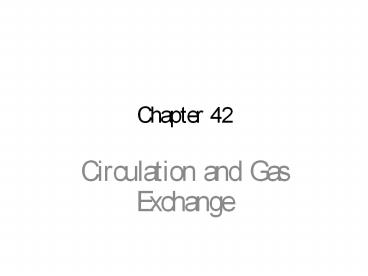Circulation and Gas Exchange - PowerPoint PPT Presentation
Title:
Circulation and Gas Exchange
Description:
Elite Animal Athletes Migratory and diving mammals have evolutionary adaptations that allow them to perform extraordinary ... When you hold your breath, you don t ... – PowerPoint PPT presentation
Number of Views:111
Avg rating:3.0/5.0
Title: Circulation and Gas Exchange
1
Chapter 42
- Circulation and Gas Exchange
2
Concept 42.7 Respiratory pigments bind and
transport gases
- The metabolic demands of many organisms require
that the blood transport large quantities of O2
and CO2
3
Respiratory Pigments
- Respiratory pigments, proteins that transport
oxygen, greatly increase the amount of oxygen
that blood can carry
4
Oxygen Transport
- The respiratory pigment of almost all vertebrates
is the protein hemoglobin, contained in
erythrocytes (red blood cell) - Hemoglobin (Hb) contains 4 individual polypeptide
chains each of which also contains one heme
group - Each heme group contains one iron atom that has
an affinity for oxygen
Iron atom
Heme group
O2 loaded in lungs
O2 unloaded in tissues
Polypeptide chain
5
Oxygen Transport
- Like all respiratory pigments, hemoglobin must
reversibly bind O2, loading O2 in the lungs and
unloading it in other parts of the body
Iron atom
Heme group
O2 loaded in lungs
O2 unloaded in tissues
Polypeptide chain
6
- Loading and unloading of O2 depend on cooperation
between the subunits of the hemoglobin molecule - The binding of O2 to one subunit induces the
other subunits to bind O2 with more affinity - Cooperative O2 binding and release is evident in
the dissociation curve for hemoglobin - A drop in pH lowers affinity of hemoglobin for O2
7
Oxygen dissociation curves - Tells us Hbs
affinity for O2 at a given pressure
O2 unloaded from hemoglobin during
normal metabolism
100
80
60
O2 saturation of hemoglobin ()
O2 reserve that can be unloaded from hemoglobin
to tissues with high metabolism
Hb is saturated with O2 when all heme groups
have attached an O2 molecule. Greater
greater affinity
40
20
0
60
40
20
0
100
80
(B) Tissues at rest
(C) Tissues during exercise
(A)Lungs
At higher altitudes, lower pressure, LESS oxygen
is present
8
Increase CO2 Increase acidity/decrease pH O2
affinity decreases Soooo Hb readily gives up
the oxygen to tissues during exercise
100
pH 7.4
80
Bohr shift additional O2 released
from hemoglobin at lower pH (higher
CO2 concentration)
O2 saturation of hemoglobin ()
60
pH 7.2
40
20
0
100
80
60
40
20
0
P (mm Hg)
O2
9
Carbon Dioxide Transport
- Hemoglobin also helps transport CO2 and assists
in buffering - Carbon from respiring cells diffuses into the
blood plasma and then into erythrocytes and is
ultimately released in the lungs
10
Tissue cell
CO2 transport from tissues
CO2 produced
Interstitial fluid
CO2
CO2
Capillary wall
Blood plasma within capillary
CO2
H2O
Hemoglobin picks up CO2 and H
Red blood cell
H2CO3 Carbonic acid
Hb
HCO3 Bicarbonate
H
HCO3
To lungs
11
CO2 transport to lungs
HCO3
H
HCO3
Hemoglobin releases CO2 and H
Hb
H2CO3
H2O
CO2
CO2
CO2
CO2
Alveolar space in lung
12
Control of Breathing in Humans
- In humans, the main breathing control centers are
in two regions of the brain, the medulla
oblongata and the pons - The medulla regulates the rate and depth of
breathing in response to pH changes in the
cerebrospinal fluid - pH changes are caused by concentration of CO2 in
the blood - The medulla adjusts breathing rate and depth to
match metabolic demands
13
- Sensors in the aorta and carotid arteries monitor
O2 and CO2 concentrations in the blood - These sensors exert secondary control over
breathing
Cerebrospinal fluid
Pons
Breathing control centers
Medulla oblongata
Carotid arteries
Aorta
Diaphragm
Rib muscles
14
Negative Feedback Loop
Holding breath CO2 levels rise
O2 / CO2 level returns to normal
Control system forces exhale, inhale
15
How a Bird Breathes
- Birds have eight or nine air sacs that function
as bellows that keep air flowing through the
lungs - Air passes through the lungs in one direction
only - How does air flow in mammals?
- Every exhalation completely renews the air in the
lungs
Air
Air
Anterior air sacs
Trachea
Posterior air sacs
Lungs
Lungs
Air tubes (parabronchi) in lung
1 mm
INHALATION Air sacs fill
EXHALATION Air sacs empty lungs fill
16
Swim Bladder
- A swim bladder is an air-filled organ fish use to
control buoyancy.
17
Elite Animal Athletes
- Migratory and diving mammals have evolutionary
adaptations that allow them to perform
extraordinary feats
18
The Ultimate Endurance Runner
- The extreme O2 consumption of the antelope-like
pronghorn underlies its ability to run at high
speed over long distances
19
Diving Mammals
- Deep-diving air breathers stockpile O2 and
deplete it slowly - CO2 lactic acid as a result from respiration is
stored until animal comes up - Also have a slow heart beat (bradycardia)































